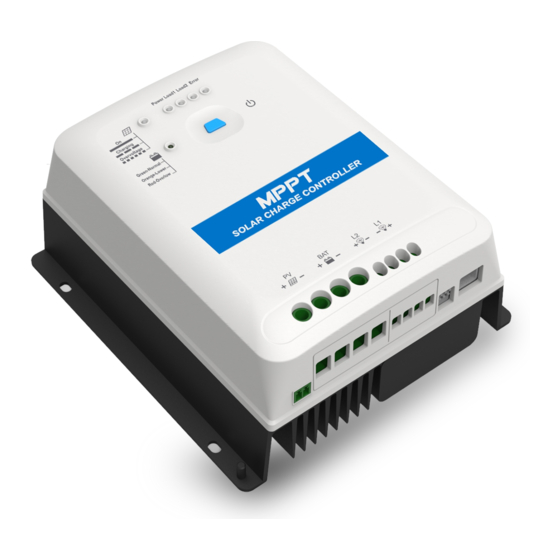
Advertisement
Quick Links
HUIZHOU EPEVER TECHNOLOGY CO., LTD.
※ Thank you for selecting the Tracer-CPN MPPT solar charge
controller. Please read this manual carefully before using the
product and pay attention to the safety information.
※ Do not install this product in humid, salt spray, corrosion,
greasy, flammable, explosive, dust accumulative, or other
severe environments.
MPPT Solar Charge Controller
1. Overview
The Tracer-CPN solar charge controller adopts the advanced Maximum Power Point
Tracking charging technology. Increase the system charging efficiency yet lower the
system cost. The controller supports various batteries, such as sealed, gel, flooded, and
lithium batteries. Users can view and modify the operational status and parameters. It
can be widely used in a solar home system, traffic signal, street light, solar garden lamp,
etc. The features are listed below:
Adopt high-quality components of ST, IR, and Infineon to ensure product lifespan
Wider working environment temperature
Apply to lead-acid battery and lithium battery
Lithium battery self-activating and low-temperature protection function
The maximum DC/DC conversion efficiency of 98%
Advanced Maximum Power Point Tracking (MPPT) technology, with tracking
efficiency of no less than 99%
Advanced MPPT control algorithm to minimize the MPP lost rate and lost time
Accurately recognizing and tracking multiple power points
PV power limitation function
Constant voltage output function
Monitoring and setting parameters via Mobile APP, PC software
Standard Modbus communication protocol for the RS485 bus connections
Connect the IoT (Internet of Things) and Cloud Server to realize remote monitoring
The RS485 port can provide a power supply
Built-in Bluetooth module (Only Tracer-CPN(BLE) supports)
Low self-consumption design, lower than 15mA
Aluminum housing for better cooling
Real-time energy statistics function
IP68 waterproof degree
2. Appearance
⑴ The RS485 waterproof port can provide a DC power of 5VDC/200mA, and have the
short-circuit protection function. The port is isolation design for Tracer7810CPN/
Tracer7810CPN(BLE), and non-isolation design for other series. The pin definition is
shown below:
Pin
Definition
VCC
+5VDC
A
RS485-A
B
RS485-B
GND
Power ground
CAUTION: When the RS485 port is not working, the waterproof cap must
be installed to prevent water from getting in.
⑵ If the temperature sensor is short-circuited or damaged, the controller shall be
charging or discharging at the default temperature of 25℃.
⑶ Only the Tracer-CPN (BLE) series are designed with the built-in Bluetooth module;
please select as you require.
3. Wiring
Connection sequence
1) Connect components to the controller in the sequence ①Battery > ②load > ③PV
as shown above and pay much attention to the "+" and "-." Please don't connect the
fast-acting fuse or circuit breaker during the installation. When disconnecting the system,
the order will be reserved.
2) The Tracer-CPN/Tracer-CPN (BLE) controllers are common-negative; all the
negative terminals can be grounded simultaneously, or anyone can be grounded.
However, according to the practical application, the negative terminals of the PV array,
battery, and load can also be ungrounded. Still, the grounding terminal on the shell must
be grounded. It effectively shields electromagnetic interference from the outside and
prevents some electric shock to the human body.
①
⑴
RS485 waterproof port
②
⑵
Temperature Sensor
③
Charging Status indicator
④
Battery Status indicator
⑤
Load Positive and Negative Wires
⑥
Battery Positive and Negative Wires
⑦
PV Positive and Negative Wires
⑧
⑶
Built-in Bluetooth module
1
Tel: +86-752-3889706
A common-negative controller for a common-negative system, such
as the motorhome, is recommended. The controller may be damaged
if a common-positive controller is used and the positive electrode is
CAUTION
grounded in the common-negative system.
3) Connect a fast-acting fuse in series with the battery positive (+). The fast-acting fuse
must be 1.25 to 2 times the rated controller current. The installed distance is within
150mm.
4) After powering the controller, the battery LED indicator on the controller shall flash
green. If it's not green, please refer to chapter 10, Troubleshooting.
Load self-test function
The load is automatically turned ON after powering on the controller for 10s. After the
load keeps ON status for 10s, the controller restores to the set working mode.
4. LED Indicators
Indicator
Color
Status
On Solid
Green
Slowly
Flashing(1Hz)
Fast Flashing(4Hz)
On Solid
Slowly
Green
Flashing(1Hz)
Fast Flashing(4Hz)
Orange
On Solid
On Solid
Red
Fast Flashing(4Hz)
Charging indicator(green) and battery
indicator(orange) flashing simultaneously
※When connecting with a lithium battery, the controller does not recognize the
system voltage automatically.
5. Load Working Mode
1) Manual Mode (Default ON)
2) Light ON/OFF
3) Light ON+ Timer
4) Real-time Control
Control the load ON/OFF time by setting a real-time clock.
In the Light ON/OFF and Light ON/Timer modes, the Load is turned
on after 10 minutes.
CAUTION
6. Accessories (optional) and Software
1)PC Software
www.epever.com ——Solar Station Monitor
2)APP Software
Android phone
www.epever.com——ChargeController(Li)
iPhone
APP Store——EPEVER——EP-01
2
Website: www.epever.com
Instruction
PV connection normal but low
voltage(irradiance) from PV,
no charging
No PV voltage(night time) or
OFF
PV connection problem
In charging
PV overvoltage
Battery normal
Battery full
Battery overvoltage
Battery under voltage
Battery over-discharged
Battery overheating
Lithium battery low
temperature
System voltage error※
Turn-On voltage (Adjustable):
5V (12Vsystem), delay10min.
Turn-Off voltage (Adjustable):
6V (12Vsystem), delay10min.
Note: 24V system voltage×2
Advertisement

Summary of Contents for Epever MPPT
- Page 1 99% Load self-test function Advanced MPPT control algorithm to minimize the MPP lost rate and lost time The load is automatically turned ON after powering on the controller for 10s. After the Accurately recognizing and tracking multiple power points load keeps ON status for 10s, the controller restores to the set working mode.
- Page 2 The controller is protected against small high-voltage transients. In lightning-prone areas, additional external arrester is recommended. Note: Only the Tracer-CPN series support the external EPEVER BLE module, the Tracer-CPN (BLE) series are already designed with a built-in Bluetooth module. 9. Troubleshooting 7.
















Need help?
Do you have a question about the MPPT and is the answer not in the manual?
Questions and answers